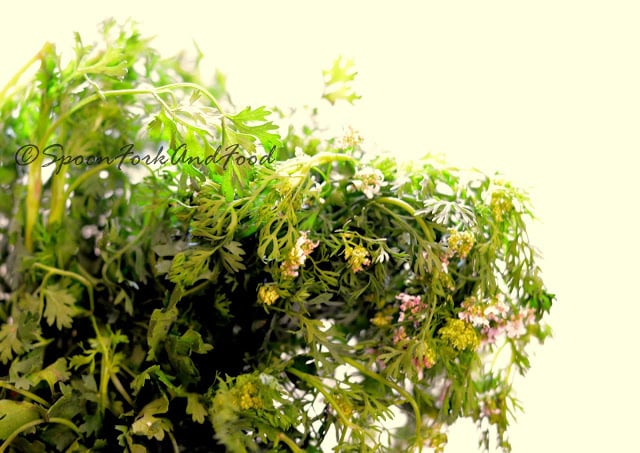
CORIANDER – the other names as Cilantro and Chinese Parsley
Internal use
The herb has great success in treating loss of appetite and other dyspeptic complaints. When used in laxatives, it eases griping.
The roots, leaves and leafstalks can be used to flavor soups, salads, beans and curries.
Dried stems are used for smoking foods.
The seeds (dried ripe fruits) are used as an ingredient of curry powders, pickles, pickling spice, baked foods, sausages and sauces.
Chewing the seeds after eating garlic is used to freshen the breath after eating garlic.
External use
Coriander is included in lotions and ointment to treat piles (hemorrhoids), rheumatism, menstrual disorders and painful joints.
Historically, the fruits have been used to treat wounds and burns and the herb has antimicrobial properties.
Aromatherapy and essential oil use
Coriander essential oil can help improve memory and has a positive effect on the digestive system. It is helpful with arthritis and rheumatism.
It helps to detoxify the body and to stimulate the spleen. It is indicated as being connected to Prana – the life-giving spark of life.
It has a hormone balancing effect and helps with menstrual problems.
It is not normally used in skin care products, but toiletry items often use it as fragrance.
It has analgesic, anti-spasmodic, carminative, deodorant, stimulant and stomachic properties.

An aging coriander is often a worry for many woman as it somewhere looses the aroma and freshness. An aging coriander can be used directly while cooking but not for garnishing. The best use of stale and aged coriander is to grind them with garlic, green chillies and tomatoes with some mint to a fine paste and used as a dip or chutney. The dip can be enjoyed with fritters, nachos, parathas, dosas or can even be used as a spread for sandwiches. To avoid coriander from aging and to keep it fresh for a longer time here are few tips :
* When you get fresh coriander, people usually keep them as a whole locked into a zip pouch in refrigerator. Instead of keeping it as a whole, it’s better to pluck the leaves, cut the roots and store them in a box with a news paper in the bottom that will absorb excess moisture and keep the coriander fresh for a longer period.
* Secondly you can simply take a flower pot or any other deep bottomed vessel. Fill water and keep the coriander bunch in it. Keep the pot in any room in normal temperature and fresh air. Preferably dinning table. By doing this you will see the coriander remain fresh for almost a month.

You should always add coriander in your daily meals as it has various medicinal benefits too…
* Clears up skin disorders such as eczema, dryness and fungal infections.
* Prevent nausea, vomiting and stomach disorders.
* Heals ulcers and freshens breath.
* Cures diarrhea and stimulates digestion.
* Reduce blood pressure.
* Helps reduce swelling due to kidney malfunction or anemia.
* Beneficial to people suffering from diabetes.
* Prevents eye from conjunctivitis.
* Prevents and cures small pox.









